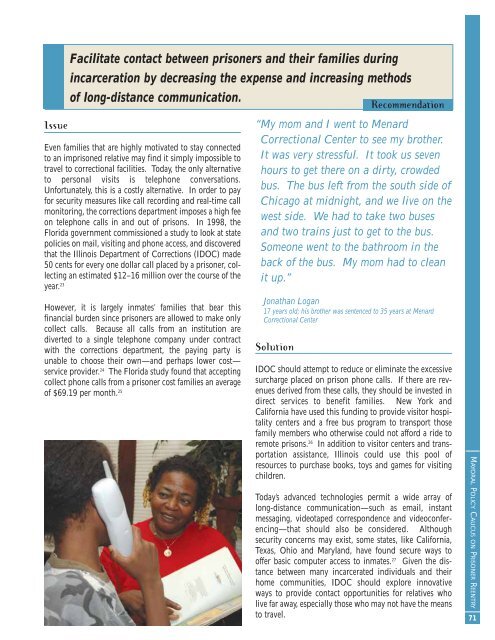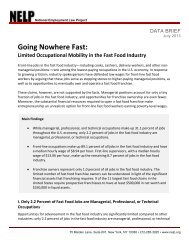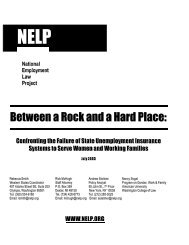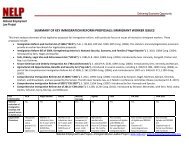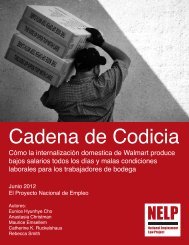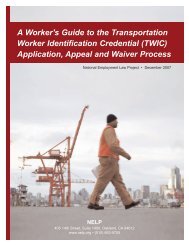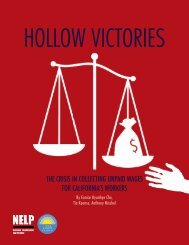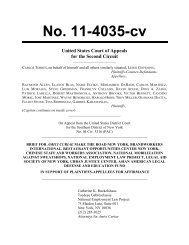Rebuilding Lives. Strengthening Communities.
Rebuilding Lives. Strengthening Communities.
Rebuilding Lives. Strengthening Communities.
Create successful ePaper yourself
Turn your PDF publications into a flip-book with our unique Google optimized e-Paper software.
Issue<br />
Facilitate contact between prisoners and their families during<br />
incarceration by decreasing the expense and increasing methods<br />
of long-distance communication.<br />
Recommendation<br />
Even families that are highly motivated to stay connected<br />
to an imprisoned relative may find it simply impossible to<br />
travel to correctional facilities. Today, the only alternative<br />
to personal visits is telephone conversations.<br />
Unfortunately, this is a costly alternative. In order to pay<br />
for security measures like call recording and real-time call<br />
monitoring, the corrections department imposes a high fee<br />
on telephone calls in and out of prisons. In 1998, the<br />
Florida government commissioned a study to look at state<br />
policies on mail, visiting and phone access, and discovered<br />
that the Illinois Department of Corrections (IDOC) made<br />
50 cents for every one dollar call placed by a prisoner, collecting<br />
an estimated $12–16 million over the course of the<br />
year. 23<br />
However, it is largely inmates’ families that bear this<br />
financial burden since prisoners are allowed to make only<br />
collect calls. Because all calls from an institution are<br />
diverted to a single telephone company under contract<br />
with the corrections department, the paying party is<br />
unable to choose their own—and perhaps lower cost—<br />
service provider. 24 The Florida study found that accepting<br />
collect phone calls from a prisoner cost families an average<br />
of $69.19 per month. 25<br />
“My mom and I went to Menard<br />
Correctional Center to see my brother.<br />
It was very stressful. It took us seven<br />
hours to get there on a dirty, crowded<br />
bus. The bus left from the south side of<br />
Chicago at midnight, and we live on the<br />
west side. We had to take two buses<br />
and two trains just to get to the bus.<br />
Someone went to the bathroom in the<br />
back of the bus. My mom had to clean<br />
it up.”<br />
Jonathan Logan<br />
17 years old; his brother was sentenced to 35 years at Menard<br />
Correctional Center<br />
Solution<br />
IDOC should attempt to reduce or eliminate the excessive<br />
surcharge placed on prison phone calls. If there are revenues<br />
derived from these calls, they should be invested in<br />
direct services to benefit families. New York and<br />
California have used this funding to provide visitor hospitality<br />
centers and a free bus program to transport those<br />
family members who otherwise could not afford a ride to<br />
remote prisons. 26 In addition to visitor centers and transportation<br />
assistance, Illinois could use this pool of<br />
resources to purchase books, toys and games for visiting<br />
children.<br />
Today’s advanced technologies permit a wide array of<br />
long-distance communication—such as email, instant<br />
messaging, videotaped correspondence and videoconferencing—that<br />
should also be considered. Although<br />
security concerns may exist, some states, like California,<br />
Texas, Ohio and Maryland, have found secure ways to<br />
offer basic computer access to inmates. 27 Given the distance<br />
between many incarcerated individuals and their<br />
home communities, IDOC should explore innovative<br />
ways to provide contact opportunities for relatives who<br />
live far away, especially those who may not have the means<br />
to travel.<br />
MAYORAL POLICY CAUCUS ON PRISONER REENTRY<br />
71


